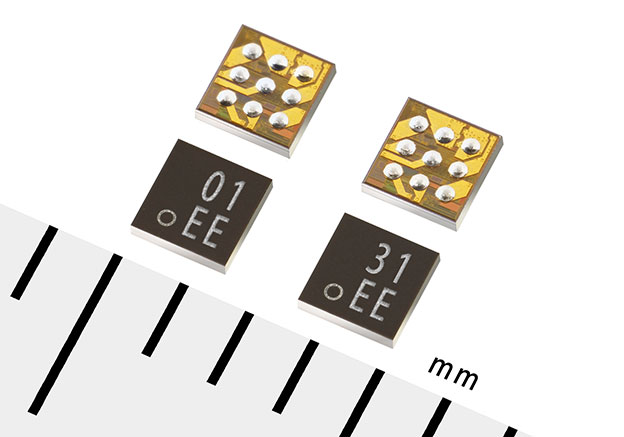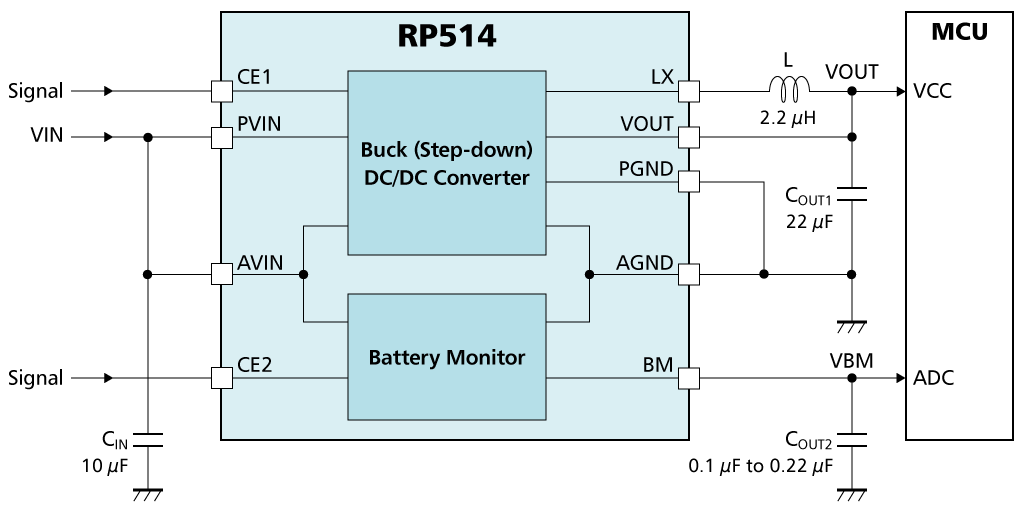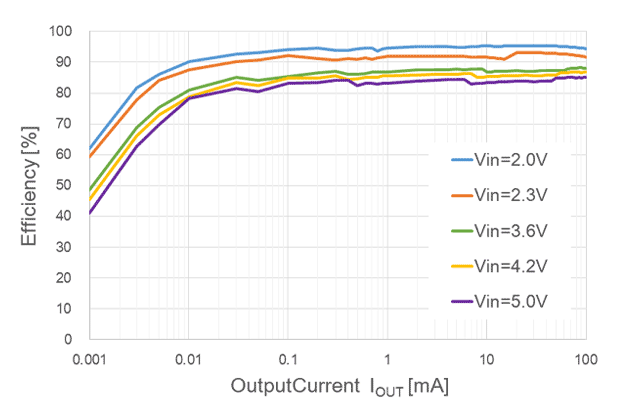News Release
Ricoh Electronic Devices Co., Ltd. Launches Ultra-low Quiescent Current Buck DC/DC Converters with Battery Monitor for IoT Equipment
January 29, 2019
Ricoh Electronic Devices Co., Ltd.
Ricoh Electronic Devices Co., Ltd. launched RP514 and RP515 series, ultra-low quiescent current buck (step-down) DC/DC converters including a battery monitor, suitable for IoT equipment.
As the IoT market expands, more and more IoT devices with sensors, MCUs, communication modules, etc. are required to have a long battery lifetime and to be small in size. At the same time, there are rising needs for functions that can monitor the battery voltage with high accuracy and low current consumption. The RP514/ RP515 can meet the needs of the market.
The products’ electric characteristics are as follows: a wide input voltage range of 1.8 V to 5.5 V; Typ. 0.4 µA quiescent current (DC/DC Section: 0.3 µA, BM Section: 0.1 µA); the user-selectable output voltage ranging from 1.0 V to 4.0 V; the output voltage accuracy of ±1.5%. The output current of the RP514 is 100 mA*1, and that of the RP515 is 300 mA*1.
Each of the new product is equipped with a battery monitor pin, which contributes to reducing external components and leakage current. Therefore, the RP514/ RP515 enable IoT devices to be small and energy-efficient.
(The divided ratio of BM output voltage is user-selectable: VIN/3 or VIN/4.)
The world's smallest WLCSP-9-P2 (1.45×1.48×0.4(max) mm) enables high-density mounting. Additionally, DFN(PLP)2527-10 (2.50×2.70×0.6(max) mm) is under development. Mass production of the package is scheduled in March, 2019.
*1: Actual output current depends on conditions and components surrounding the product. The value mentioned here is a reference value under certain conditions.

RP514/ RP515 Series (WLCSP-9-P2)
Product Features of the RP514/ RP515
The RP514/ RP515 are buck DC/DC converters that achieve ultra-low quiescent current and space-saving design, suitable for IoT devices.
1. Battery Monitor
RP514/ RP515 don't require any external components to divide the input voltage for battery monitor, while the conventional circuits mentioned above do.

Typical Applications of RP514 Series
2. Ultra-low Quiescent Current
The RP514/ RP515 achieve ultra-low quiescent current of Typ. 0.4 µA (DC/DC Section: 0.3 µA, BM Section: 0.1 µA), contributing to the long-time operation of IoT devices.
3. Wide Input Voltage Range
The RP514/ RP515 can correspond to various batteries such as coin-shaped batteries, next-generation batteries, capacitors, etc., due to the wide input voltage range of 1.8 V to 5.5 V. Moreover, the least operating voltage of 1.8 V helps prolong the battery lifetime.
4. Small Packages Reducing Mounting Area
WLCSP-9-P2 and DFN(PLP)2527-10 are adopted to the new products. The small packages contribute to reducing the mounting area.
Product Specifications
| Product Name | RP514 series / RP515 series |
|---|---|
| Supply Current | Typ. 0.4 µA (At No Load) (DC/DC Section: 0.3 µA, BM Section: 0.1 µA) |
| Input Voltage Range (VIN) | 1.8 V to 5.5 V (Rating: 6.5 V) |
| Output Voltage Range (VOUT) | 1.0 V to 4.0 V |
| Output Voltage Accuracy | ±1.5% |
| Output Current | RP514 series: 100 mA*2 RP515 series: 300 mA*2 |
| Output Voltage (BM Section) | VIN/3 or VIN/4 User-selectable |
| Auto-discharge | Yes / No User-selectable |
| Ceramic Capacitor Available | BM Section: 100 to 220 nF |
*2: Actual output current depends on conditions and components surrounding the product. The value mentioned here is a reference value under certain conditions.
RP514 Series Typical Characteristics (VOUT=1.8V,Ta=25°C)

RP515 Series Typical Characteristics (VOUT=1.8V,Ta=25°C)

Learn More:
Related Links
Supporting your IoT system construction
Incorporating battery voltage monitoring into power management IC helps to reduce the size, prolong battery life and contribute to long-term operation of IoT devices.
We provide IoT equipment with semiconductor devices that feature low current consumption, low noise, and small size by the highest level of CMOS analog technology, and thereby strengthens your competitive edge.








